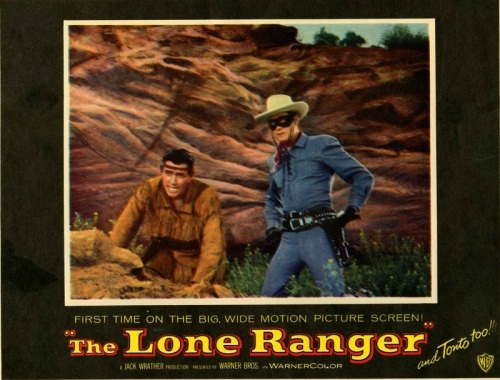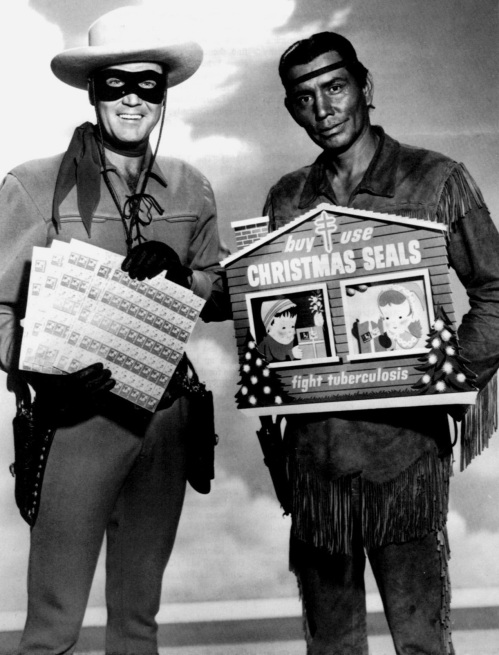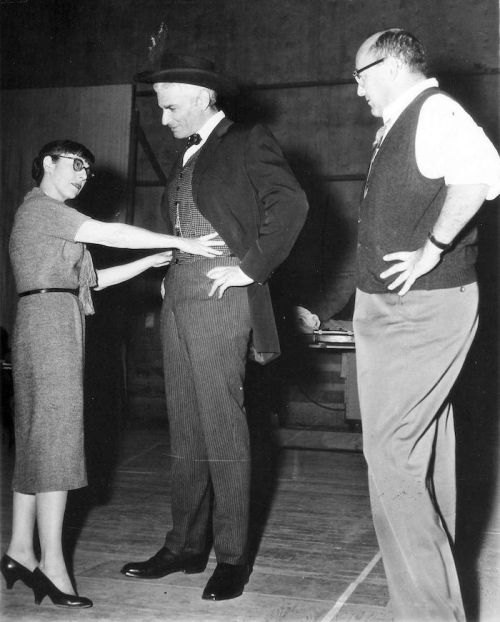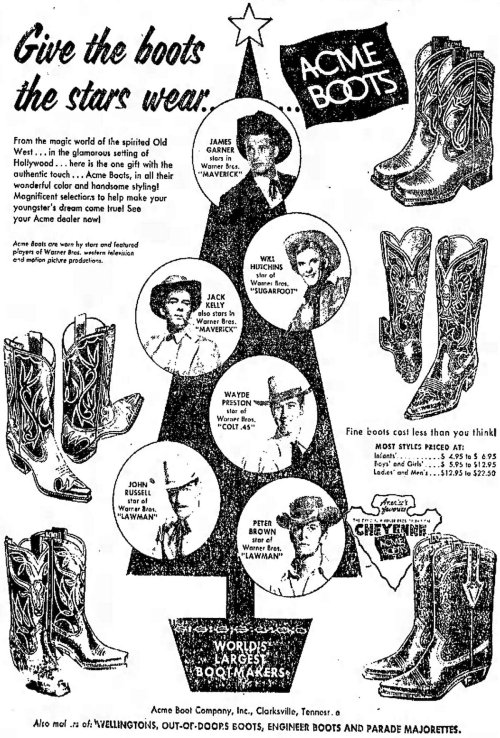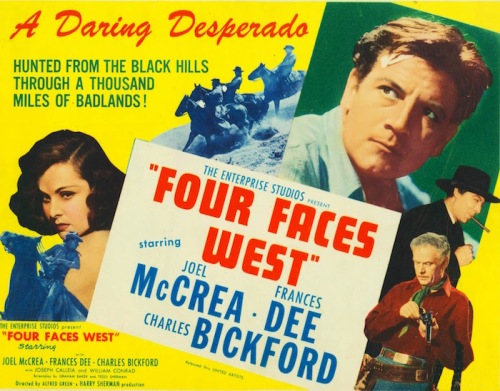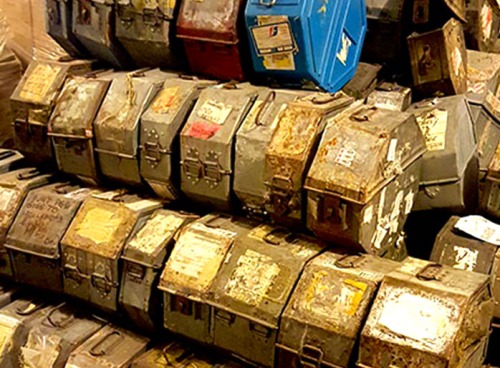
James Abbott has been riding along with this blog for years. He and I often get into back-and-forth email exchanges, usually about The Lone Ranger. In one of our recent “conversations,” he hit upon some stuff worth sharing with everybody, so I asked him to expand it into a post. He graciously agreed. Check out his blog The Jade Sphinx sometime.
__________
When I first stumbled on The Lone Ranger, it was love at first sight. And I’m not alone — the character has been an enduring icon and source of inspiration ever since he first appeared in 1933. There are few characters as familiar or beloved, and I think it fitting at the start of a New Year to talk about Lone Ranger and his place in the American mythos.
Born in 1962, I grew up during the great nostalgia craze of the 1960s and 70s. I stayed up late to watch Buster Crabbe as Buck Rogers, read reprints of Little Orphan Annie and Doc Savage, and saw the Marx Brothers on the big screen in revival houses. Great recordings from the 30s and 40s were reissued, and it’s not surprising that the first concert I ever went to was Bing Crosby when he played the Uris Theater in New York. It wasn’t that everything old was new again; for me, it was just new.
 The big discovery for me, of course, was Old Time Radio. The local station, WRVR-FM, had a nightly rotation of vintage shows, and I was spellbound. The lineup included The Shadow, Fibber McGee and Molly, Gangbusters, The Green Hornet and … The Lone Ranger. In the first bloom of friendship, “those thrilling days of yesteryear” were both the 1930s and 40s, and the Old West.
The big discovery for me, of course, was Old Time Radio. The local station, WRVR-FM, had a nightly rotation of vintage shows, and I was spellbound. The lineup included The Shadow, Fibber McGee and Molly, Gangbusters, The Green Hornet and … The Lone Ranger. In the first bloom of friendship, “those thrilling days of yesteryear” were both the 1930s and 40s, and the Old West.
The Lone Ranger was created by writer Fran Striker (1903-1962) and he first appeared in 1933 on radio station WXYZ, owned by George W. Trendle (1884-1972), who also claimed credit for creating the Ranger. The show was an enormous hit – it was geared towards kids, but more than half of the audience was made up of adults. The show would last on radio until 1954 – but, as is often the case, the Lone Ranger was to ride again in a television show from 1949 to 1957. The Lone Ranger was also the subject of two movie serials, four motion pictures (and, yes, I loved the Disney film), and one execrable TV movie.

I came to the Lone Ranger long before I came to my great love of the Wild West, but he still encapsulates everything that is big, heroic and inspirational about the West.
Back in the early 70s, I listened every week. I bought cassette tapes of other episodes. I bought records featuring new recordings of radio star Brace Beemer retelling the origin (or creation myth) of the Ranger, Tonto and Silver, and the end of Butch Cavendish. And then, when the local television station started playing the Clayton Moore and Jay Silverheels television version, I felt as if I were reuniting with old friends.
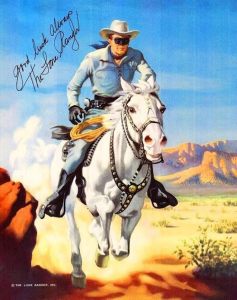 It was a friendship built to last. For nearly 25 years, a portrait of the Lone Ranger hung in my office, and as I write these words, a statue of him astride a rearing Silver stands on my desk.
It was a friendship built to last. For nearly 25 years, a portrait of the Lone Ranger hung in my office, and as I write these words, a statue of him astride a rearing Silver stands on my desk.
So, the Ranger has been a constant in my life for as long as I can remember. But … why? What is it about the Lone Ranger and Tonto that has made them my trusted companions for more than 40 years?
I will be the first to admit that there was as much corn as gold in our Golden Age of Pop Culture. However… there is something about the Lone Ranger that still resonates, still has the capacity to touch some more innocent and hopeful self. And I say without shame and certainly without irony that I love him and continue to be inspired by him.
The Lone Ranger is a remarkable creation for a number of reasons. First off, Striker and company hit some kind of nerve in creating a kiddie show character that so resonated with adults. To understand the Lone Ranger’s popularity at the time with both children and adults, think of our contemporary obsession with Batman – and then realize that the Lone Ranger was even more popular in his prime.
The Lone Ranger, however, has no superpowers. What makes him special is his ethical approach to everything and everyone, the exercise of his superior moral code. The Lone Ranger has always been my hero because I could aspire to be like him – in fact, I wanted to be like him. It was an ideal that I wanted because he made me a better, rather than a more powerful, person. The Lone Ranger is all the things that America once told Americans about themselves, the personification of the decency and simple integrity first found in our frontier forebears, and still residing in us today.
The Lone Ranger was not “in it” for the money. In fact, it seems as if the Lone Ranger and Tonto lived on the road, camping outside of town. He did not help people for personal fame or self-aggrandizement; in fact, he always left before anyone could properly thank him. Finally, the Ranger made life better for those around him, and that seemed to be his sole motivation.
The Lone Ranger was also a role-model in how to conduct a deep friendship. Though many misremember Tonto as a monosyllabic stooge, Tonto actually was the Ranger’s superior in woodcraft and outdoorsmanship, and was an excellent scout and information resource. More often than not, it was Tonto who did the initial reconnaissance and told the Ranger who and where the villains could be found. The Lone Ranger and Tonto form a true friendship – both men cared for and loved each other. (As is often the case with these long-lasting sagas, there is some debate as to how the two actually met. The current story is that they were boyhood friends and it was chance that brought Tonto to Bryant’s Gap after the ambush. Each man calls the other Kemo Sabe, which means “faithful friend.”)
 The people helped by the Lone Ranger and Tonto often reacted as if they were suddenly brought face-to-face with a great living, breathing All-American myth. And they were! Part of the Ranger’s power as a character is that he is larger-than-life, but built on human dimensions. His appearances had all the trapping of an angelic visitation – but he always left a silver bullet behind so you knew it all really happened.
The people helped by the Lone Ranger and Tonto often reacted as if they were suddenly brought face-to-face with a great living, breathing All-American myth. And they were! Part of the Ranger’s power as a character is that he is larger-than-life, but built on human dimensions. His appearances had all the trapping of an angelic visitation – but he always left a silver bullet behind so you knew it all really happened.
The Lone Ranger’s moral code meant that he never took a life, never shot to kill, never took unfair advantage. Today, a concept like that would never fly, but the Ranger comes from different times and a different America – a more aspirational land when we wanted people to emulate rather than feel smugly superior.
The Lone Ranger code was:
I believe…
That to have a friend, a man must be one.
That all men are created equal and that everyone has within himself the power to make this a better world.
That God put the firewood there, but that every man must gather and light it himself.
In being prepared physically, mentally, and morally to fight when necessary for that which is right.
That a man should make the most of what equipment he has.
That ‘this government of the people, by the people, and for the people’ shall live always.
That men should live by the rule of what is best for the greatest number.
That sooner or later…somewhere…somehow…we must settle with the world and make payment for what we have taken.
That all things change but truth, and that truth alone, lives on forever.
In my Creator, my country, my fellow man.
You can learn a lot about a people by the stories they tell about themselves. They don’t have to be true … they just have to be how a people think of and see themselves. At one time, Americans saw the Lone Ranger, and saw themselves.
I could never be like the Lone Ranger. I am, at heart, not as inherently kind, as unfailingly generous, as expansive of heart as the Ranger. I have grown too cynical in too many ways, and life has managed to throw me too many curves. But the hope – the expectation – that I could, maybe on a good day, be a little more like him continues to be as strong as ever.
 That part of me has been hiding in there somewhere for 54 years, and shows no sign of leaving yet. And as the New Year is upon us, and people writing up their New Year Resolutions, I keep thinking, What Would the Lone Ranger Do? It would make a great ethical compass with which to live by.
That part of me has been hiding in there somewhere for 54 years, and shows no sign of leaving yet. And as the New Year is upon us, and people writing up their New Year Resolutions, I keep thinking, What Would the Lone Ranger Do? It would make a great ethical compass with which to live by.
The creators of the Lone Ranger wanted to create a myth that was actively striving to live larger than all of us, to be both an ideal and an inspiration. And though no one could really live up to the impossibly high bar of moral behavior the Ranger erects, it is certainly something to work towards.
Who was that Masked Man? He was the best part of ourselves.
And so, on to 2017. Hi-yo Silver, away!
